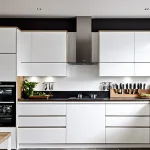Essential Features of Contemporary UK Kitchen Design
Contemporary UK kitchens blend style and function, reflecting modern kitchen features that suit today’s lifestyles. Their hallmarks include clean lines, minimalist cabinetry, integrated appliances, and clever use of space, all tailored to British homes’ unique layouts.
Modern kitchen features prioritize usability and aesthetics. For instance, handleless cabinets create a sleek look while maximizing storage. Neutral colour palettes—think soft greys and whites—enhance natural light, a key consideration in many UK kitchens. Durable surfaces like quartz or laminate balance beauty with practicality. Additionally, energy-efficient appliances are vital, aligning with sustainability goals increasingly important in the UK.
Topic to read : Boosting kitchen productivity: top strategies for uk restaurants to enhance workflow efficiency
A design checklist for contemporary UK kitchen success covers:
- Efficient workflow zones for cooking, prep, and cleaning
- Adequate storage to minimize clutter
- Integrated lighting that brightens worktops without glare
- Ventilation solutions tailored for UK homes’ often compact spaces
Modern kitchen features should merge style and functionality seamlessly. This ensures the kitchen is not only a focal point but also a comfortable, efficient place for daily use.
Topic to read : Blending heritage and innovation: the evolution of uk kitchen bars
Optimal Kitchen Layouts and Space Planning
Designing a kitchen that balances style and practicality starts with kitchen layout ideas tailored to your space. In UK kitchen planning, three layouts stand out: galley, L-shaped, and open-plan. The galley layout suits narrow spaces, maximizing efficiency by positioning work zones opposite each other. For larger kitchens, the L-shaped layout offers flexibility, freeing up corners for storage or appliances. Open-plan designs merge cooking and living areas, ideal for modern homes that prioritize social interaction.
Efficient space use is crucial, especially in compact UK kitchens. Strategies include vertical storage, pull-out pantry units, and clever corner cupboards. In smaller kitchens, integrating dining and social areas prevents overcrowding while maintaining functionality. For example, a breakfast bar can double as a dining spot and prep surface.
By focusing on these layouts and space-saving methods, you can create a kitchen that feels spacious and inviting without compromising on utility. This approach ensures your kitchen supports both daily tasks and social needs elegantly.
Popular Colour Schemes and Finishes
Exploring UK kitchen colour trends reveals a strong preference for neutral tones with bold accents. Shades like soft greys, chalky whites, and muted blues dominate, offering a versatile canvas for modern living spaces. These palettes align well with contemporary design, creating an inviting yet stylish atmosphere.
The choice of kitchen finishes significantly affects the overall aesthetic. Matte finishes provide a sleek, understated look, minimizing reflection and hiding fingerprints, ideal for busy households. Conversely, gloss finishes amplify light, enhancing the kitchen’s brightness and sense of space. Metallic finishes, often in handles or splashbacks, add subtle sophistication and contrast, while wood finishes introduce warmth and texture, grounding the room in natural charm.
Together, these finishes interact with colour schemes to shape perception. For instance, pairing matte navy cabinets with metallic accents creates a balanced yet dynamic feel, while combining gloss white surfaces with wood elements can soften modern minimalism. Selecting the right combination ensures your kitchen not only looks contemporary but also reflects personal style and practical needs.
Cabinetry Styles and Storage Solutions
When it comes to kitchen cabinetry, modern designs emphasize both style and efficiency. One popular trend is handleless cabinets, which offer a sleek, minimalist appearance while making cleaning easier. These cabinets use push-to-open mechanisms or recessed pulls, maintaining a smooth surface that complements contemporary kitchens.
Innovations in storage ideas are transforming kitchen functionality. Pull-out shelves and deep drawers maximize space by providing easy access to pots, pans, and pantry items. Corner solutions, like rotating carousels or swing-out racks, tackle traditionally hard-to-reach areas, making full use of every inch. These options not only keep clutter at bay but also help streamline cooking routines.
For homeowners seeking a balance between aesthetics and utility, choosing cabinetry with smart storage solutions enhances kitchen usability without sacrificing style. Handleless cabinets paired with innovative storage elements create an organized, modern space that’s as attractive as it is practical.
Worktops and Materials: Durability Meets Style
Choosing the right kitchen worktops combines durability with aesthetic appeal. Among popular material choices, quartz stands out for its resilience and low maintenance. Made from engineered stone, quartz offers a non-porous surface that resists stains and scratches, making it ideal for busy kitchens where longevity is essential.
Solid surface materials, like Corian, provide seamless designs and easy repairs but might lack the heat resistance of quartz. Granite remains a classic, praised for its natural beauty and toughness, though it needs periodic sealing to maintain its performance. Laminate is a budget-friendly alternative with endless styles, although it is more prone to wear and damage.
When selecting worktop materials, consider how they will coordinate with cabinetry and floors. A quartz worktop with neutral tones can complement sleek, modern cabinets and hardwood flooring, creating a cohesive kitchen design. Balancing durability with style ensures your kitchen worktops serve you well for years while enhancing your space’s overall look.
Lighting Techniques for Contemporary Spaces
Contemporary kitchen lighting trends emphasize a balance between task and ambient light to enhance both functionality and mood. The three key lighting layers—task, ambient, and accent—work together to ensure every corner is well-lit while creating inviting atmospheres. Task lighting focuses on areas like countertops and sinks, where precision is essential. Under-cabinet LED lighting is a popular choice here, offering bright, shadow-free illumination that improves cooking accuracy.
Ambient lighting provides overall, uniform brightness. Recessed LED fixtures are commonly used for this purpose in modern kitchens, delivering energy-efficient, long-lasting light without cluttering the ceiling. Accent lighting, such as pendant lamps over kitchen islands, adds visual interest and highlights specific features, blending practicality with style.
Integrating smart lighting controls allows users to adjust brightness and color temperature according to their activities and preferences, enhancing energy efficiency. These cutting-edge systems promote sustainability while maximizing convenience, making them a hallmark of contemporary kitchen lighting trends.
Embracing Smart Appliances and Technology
Smart kitchen appliances are revolutionizing homes across the UK, blending integrated technology with everyday cooking and cleaning routines. These devices, from Wi-Fi-enabled ovens to voice-controlled refrigerators, offer convenience by syncing seamlessly with smartphones and other smart home systems.
UK trends highlight a strong shift towards appliances that support remote operation, energy efficiency, and personalized settings. For example, smart ovens allow users to preheat or monitor cooking progress via mobile apps, while dishwashers adapt cycles based on soil levels detected in real time. This integration not only saves time but also reduces energy waste.
Looking ahead, innovations like AI-driven cooking assistants and appliances capable of learning user habits are gaining traction. These future technologies promise to further simplify tasks and customize experiences, making smart kitchen appliances essential for the modern household. Embracing such connectivity enhances functionality and prepares homes for increasing digital lifestyles.
Maximizing Functionality in Compact Kitchens
Creating a functional kitchen in a limited space demands creative small kitchen ideas tailored for UK urban kitchens. One of the most effective methods is investing in multifunctional appliances—for example, a combination oven or a fridge with integrated freezer compartments helps reduce footprint while maintaining utility. Furniture that folds or nests can provide valuable flexibility; consider tables that expand or chairs that double as storage units.
Optimizing storage is another cornerstone of space-saving solutions. Use vertical space with wall-mounted shelves, magnetic knife strips, and pegboards to keep tools accessible without cluttering surfaces. Installing pull-out drawers and lazy Susans in corners maximizes often neglected spots.
Visual tricks also dramatically improve the feeling of roominess. Mirrors or glossy backsplashes reflect light, while a consistent color scheme with lighter tones creates continuity. Glass cabinet doors open the space visually, making UK urban kitchens feel larger and more inviting. Together, these strategies transform compact kitchens into highly efficient, stylish environments suited to busy urban lifestyles.
Expert Tips for a Cohesive Modern UK Kitchen
Creating a cohesive style in a modern UK kitchen relies heavily on deliberate choices in colour, materials, and lighting. Experts recommend starting with a neutral palette, mixing warm and cool tones to achieve balance. Using natural materials like wood or stone alongside sleek metals adds texture without overwhelming the space. Lighting plays a pivotal role—layered solutions such as recessed lights combined with pendant fixtures ensure both functionality and ambiance.
Avoiding common kitchen design pitfalls starts with resisting overly trendy finishes that quickly date a space. Instead, focus on timeless elements that can blend with evolving decor. For example, matte cabinetry paired with polished surfaces strikes a refined balance while being easy to refresh with accessories.
To create a modern yet enduring kitchen, embrace simplicity and subtle contrasts. Prioritise clean lines and integrated appliances to support a streamlined look. These expert kitchen design tips encourage homeowners to craft a space that feels fresh today and remains stylish for years, marrying contemporary appeal with classic sensibility.

